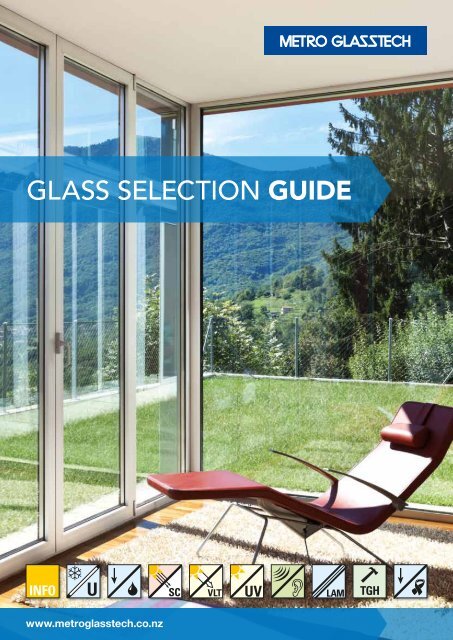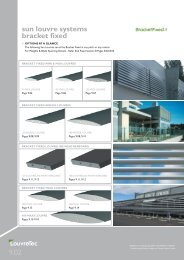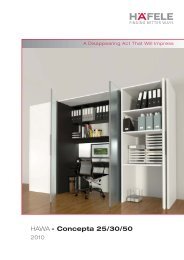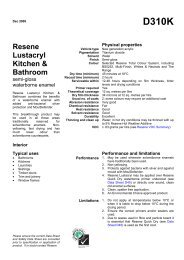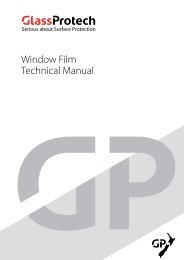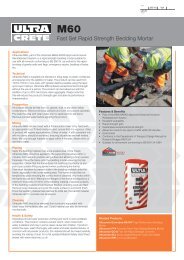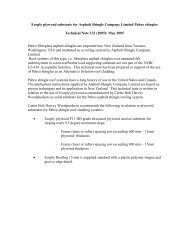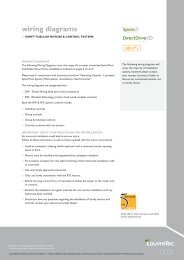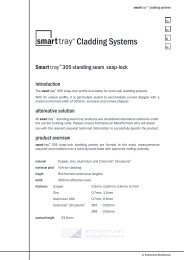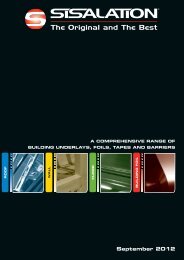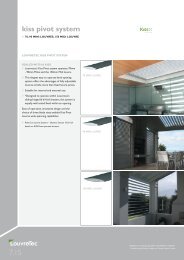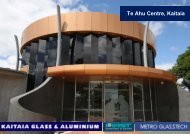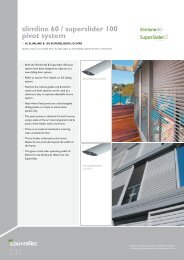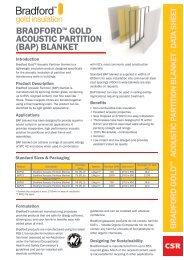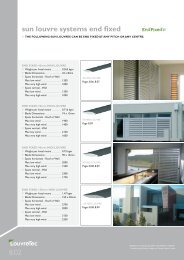GLASS SELECTION GUIDE - Eboss
GLASS SELECTION GUIDE - Eboss
GLASS SELECTION GUIDE - Eboss
Create successful ePaper yourself
Turn your PDF publications into a flip-book with our unique Google optimized e-Paper software.
<strong>GLASS</strong> <strong>SELECTION</strong> <strong>GUIDE</strong><br />
www.metroglasstech.co.nz
<strong>GLASS</strong> <strong>SELECTION</strong><br />
The Glass Selection Flow Chart should be used in conjunction with the Selection Sheets and Section 11.1.2<br />
of the Catalogue and Reference Guide to assist with solving each design challenge you are faced with.<br />
FLOW CHART<br />
Circle priority number in each step. Each step is detailed in 11.1.2 Glass Selection Guide. Priority 1 = Highest, Priority 5 = Lowest<br />
Start here<br />
Go to<br />
Step 1<br />
Do you want to<br />
Reduce Heat Loss<br />
Priority 1 2 3 4 5<br />
Yes<br />
Circle priority 1-5<br />
and go to Step 2<br />
No<br />
Step 2<br />
Do you want to<br />
Control Condensation<br />
Priority 1 2 3 4 5<br />
Yes<br />
Circle priority 1-5<br />
and go to Step 3<br />
No<br />
Step 3<br />
Do you want to<br />
Reduce Heat Gain<br />
Priority 1 2 3 4 5<br />
Yes<br />
Circle priority 1-5<br />
and go to Step 4<br />
No<br />
Step 4<br />
Do you want to<br />
Reduce Glare<br />
Priority 1 2 3 4 5<br />
Yes<br />
Circle priority 1-5<br />
and go to Step 5<br />
No<br />
Step 5<br />
Do you want to<br />
Reduce Fading<br />
Priority 1 2 3 4 5<br />
Yes<br />
Circle priority 1-5<br />
and go to Step 6<br />
No<br />
Step 6<br />
Do you want to<br />
Reduce Noise<br />
Priority 1 2 3 4 5<br />
Yes<br />
Circle priority 1-5<br />
and go to Step 7<br />
No<br />
Step 7<br />
Do you want to<br />
Increase Safety<br />
Priority 1 2 3 4 5<br />
CIP<br />
Yes<br />
Circle priority 1-5<br />
and go to Step 8<br />
Step 8<br />
Do you want to<br />
No<br />
Improve Aesthetics<br />
Priority 1 2 3 4 5<br />
Yes<br />
Circle priority 1-5 ,<br />
select colour preference<br />
and go to Step 9<br />
No<br />
What glass colour is preferred<br />
Clear<br />
Blue Dark Medium Light<br />
Green Dark Medium Light<br />
Bronze Dark Medium Light<br />
Grey Dark Medium Light<br />
Reflective High Medium Low<br />
Step 9<br />
Do you want to<br />
Glaze Large Windows<br />
Priority 1 2 3 4 5<br />
Yes<br />
Circle priority 1-5, fill in detail<br />
and go to FINISH<br />
No<br />
FINISH<br />
Largest window size=height<br />
Windzone or windload<br />
x width<br />
www.metroglasstech.co.nz<br />
April 2013
PERFORMANCE<br />
The Performance Data Graph below is designed to enable key performance properties of different glass<br />
types to be plotted and compared with each other. The performance data can be taken from Section 12<br />
of the Catalogue and Reference Guide or from other reliable sources.<br />
The plotted glass performance can be compared with the ‘Rating Zone’ which gives a guide to good<br />
all-round performance of the glazing.<br />
Note: In some cases specific design requirements may mean the ideal glass is outside the ‘Rating Zone’.<br />
Performance<br />
Glass Type Glass type<br />
Quick Reference Symbols heat loss &<br />
fading glare heat gain condensation acoustics<br />
%<br />
Rating Zone<br />
FRC VLT SC U PSR<br />
From:<br />
fading visable Performance shading Data Symbols<br />
reduction light coefficient<br />
coefficient transmission<br />
Notes:<br />
u value<br />
percieved<br />
sound<br />
reduction<br />
Phone:<br />
www.metroglasstech.co.nz<br />
April 2013
HEAT LOSS<br />
(INSULATION)<br />
Heat Loss from the thermal envelope is a key factor in modern housing design.<br />
In winter the Insulating Glass Unit can trap heat inside the house and thus reduce the amount<br />
of heating required (kWh) to maintain a comfortable environment.<br />
In summer the Insulating Glass Unit can trap the cool air inside the house and reduce the amount<br />
of cooling required to maintain a comfortable environment.<br />
In all seasons the Insulating Glass Unit can reduce the energy loads on Heating, Ventilating and<br />
Air Conditioning (HVAC) systems.<br />
GOOD<br />
4mm clear<br />
12mm airspace<br />
4mm clear<br />
Solution:<br />
GlassTech IGU<br />
Is GOOD because it meets the minimum<br />
requirements for thermal insulation for<br />
housing and small buildings (NZS 4218).<br />
INNER<br />
OUTER<br />
BETTER<br />
4mm Low E<br />
12mm airspace<br />
4mm clear<br />
Solution:<br />
GlassTech Low E + IGU<br />
Low E glass provides BETTER thermal<br />
insulation as it traps the heat inside by<br />
reflecting long wave radiation.<br />
INNER<br />
OUTER<br />
BEST<br />
4mm Low E<br />
INNER<br />
12mm Argon<br />
4mm clear<br />
OUTER<br />
Thermal<br />
spacer<br />
Solution:<br />
GlassTech Low E + IGU<br />
and Argon +<br />
By combining Low E glass and argon gas<br />
the BEST thermal insulation is achieved.<br />
Thermal spaces can be used in thermally<br />
efficient frames to improve the total<br />
window performance.<br />
www.metroglasstech.co.nz April 2013
PERFORMANCE DATA<br />
The following tables compare the insulation performance of clear glass IGUs, for a range of air or argon<br />
spaces. The heat loss reduction % compares the heat loss (U Value) to that of single 4mm clear glass.<br />
Changing the glass thickness will have minimal effect on the insulation.<br />
GOOD<br />
12mm airspace<br />
4mm clear 4mm clear<br />
Insulation comparison<br />
Type<br />
Outer Glass<br />
(mm)<br />
Air Space<br />
(mm)<br />
Inner Glass<br />
(mm)<br />
U Value*<br />
Heat Loss<br />
Reduction**<br />
4 Clear 6 4 Clear 3.15 46%<br />
4 Clear 8 4 Clear 2.94 50%<br />
OUTER<br />
INNER<br />
1 2 3 4 surface<br />
#<br />
GlassTech IGU<br />
4 Clear 10 4 Clear 2.83 52%<br />
4 Clear 12 4 Clear 2.73 54%<br />
4 Clear 14 4 Clear 2.70 54%<br />
4 Clear 16 4 Clear 2.72 54%<br />
BETTER<br />
12mm airspace<br />
4mm clear 4mm Low E<br />
Insulation comparison<br />
Type<br />
Outer Glass<br />
(mm)<br />
Air Space<br />
(mm)<br />
Inner Glass<br />
(mm)<br />
U Value*<br />
Heat Loss<br />
Reduction**<br />
4 Clear 6 4 N70 Low E 2.56 57%<br />
4 Clear 8 4 N70 Low E 2.24 62%<br />
OUTER<br />
INNER<br />
1 2 3 4 surface<br />
#<br />
GlassTech Low E +<br />
IGU (Climaguard<br />
N70 Low E # 3)<br />
4 Clear 10 4 N70 Low E 2.07 65%<br />
4 Clear 12 4 N70 Low E 1.92 67%<br />
4 Clear 14 4 N70 Low E 1.93 67%<br />
4 Clear 16 4 N70 Low E 1.96 67%<br />
BEST<br />
12mm Argon<br />
4mm clear 4mm Low E<br />
Insulation comparison<br />
Type<br />
Outer Glass<br />
(mm)<br />
Argon Space<br />
(mm)<br />
Inner Glass<br />
(mm)<br />
U Value*<br />
Heat Loss<br />
Reduction**<br />
4 Clear 8 4 N70 Low E 1.90 68%<br />
OUTER<br />
INNER<br />
1 2 3 4 surface<br />
#<br />
GlassTech Low E +<br />
Argon + IGU<br />
(Climaguard N70<br />
Low E # 3)<br />
4 Clear 10 4 N70 Low E 1.77 70%<br />
4 Clear 12 4 N70 Low E 1.68 72%<br />
4 Clear 14 4 N70 Low E 1.71 71%<br />
4 Clear 16 4 N70 Low E 1.73 71%<br />
* U Values are centre of glass values in W/m2K calculated on Thermal 5.2.6 software using NFRC 100-2004 conditions - Argon spaces are 90% argon and 10% air.<br />
** Heat Loss Reduction is calculated compared to 4mm clear float (U value = 5.89).<br />
# Surface number.<br />
The Good, Better, Best approach is a simplification of the complexity surrounding the selection of the<br />
correct glass to provide the best design solution, and therefore other options, not listed on this sheet, are<br />
available from Metro GlassTech. In addition other factors can affect the glass selection such as the risk<br />
of thermal stress breakage and the requirements to comply with the NZ Building Code and NZS 4223.<br />
www.metroglasstech.co.nz<br />
April 2013
CONDENSATION<br />
Internal condensation that forms on glazing is a key factor in modern housing design.<br />
Condensation can damage fabrics, furnishings and framing and create an unhealthy environment.<br />
Condensation is a function of relative humidity (%RH) of the air, the indoor and outdoor temperature and the<br />
insulation properties (U value) of the glazing.<br />
Insulating Glass Units can reduce the onset of internal condensation by keeping the interior glass surface warmer.<br />
GOOD<br />
Clear glass<br />
INNER<br />
Clear glass<br />
OUTER<br />
Solution:<br />
GlassTech IGU<br />
Is GOOD because it meets the<br />
minimum requirements for thermal<br />
insulation for housing and small buildings<br />
(NZS 4218) and keeps the inside glass<br />
surface warmer than single glazing.<br />
BETTER<br />
Low E glass<br />
Clear glass<br />
Solution:<br />
GlassTech Low E + IGU<br />
Low E glass provides BETTER thermal<br />
insulation as it traps heat inside by<br />
reflecting long wave radiation and<br />
keeping the inner glass warmer.<br />
INNER<br />
OUTER<br />
BEST<br />
Low E glass<br />
INNER<br />
Argon gas<br />
Clear glass<br />
OUTER<br />
Solution:<br />
GlassTech Low E + and Argon + IGU<br />
By combining Low E glass and argon gas the<br />
BEST thermal insulation is achieved and the<br />
inner glass at it warmest.<br />
Thermal spacers can be used in thermally<br />
efficient frames to improve the total window<br />
performance, and the edge area condensation<br />
that can occur with normal windows.<br />
PERFORMANCE DATA – Refer to Metro GlassTech Catalogue and Reference Guide Section 11.2.5.<br />
External dew (which is sometimes known as external condensation) can occasionally occur on the outside of high performance<br />
Insulating Glass Units in temperate climates.<br />
The Good, Better, Best approach is a simplification of the complexity surrounding the selection of the<br />
correct glass to provide the best design solution, and therefore other options, not listed on this sheet, are<br />
available from Metro GlassTech. In addition other factors can affect the glass selection such as the risk<br />
of thermal stress breakage and the requirements to comply with the NZ Building Code and NZS 4223.<br />
www.metroglasstech.co.nz<br />
April 2013
CONDENSATION<br />
Air is a mixture of gases including water vapour. At any given<br />
temperature there is a limiting maximum vapour pressure,<br />
called the saturated vapour pressure, where the air cannot<br />
hold any more water vapour. If air, containing water vapour,<br />
comes into contact with a cooler surface the excess moisture<br />
is deposited on the surface as condensation.<br />
The surface temperature at which condensation begins to<br />
form is called the “Dew Point”. The ratio of the water vapour<br />
pressure at room temperature to the saturated water vapour<br />
pressure at that temperature is known as the “Relative<br />
Humidity” (RH), and is expressed as a percentage.<br />
Relative Humidity is a measure of the water content of the air<br />
at a given temperature. Many domestic activities, such as<br />
cooking and washing, will liberate water vapour and increase<br />
the relative humidity and thus the occurrence of condensation.<br />
In all cold temperature climates, condensation can occur on<br />
the inside of windows when the external temperature falls<br />
significantly below the internal temperature and cools the glass.<br />
The onset of condensation on the interior glass surface<br />
can be controlled either by reducing the humidity, thereby<br />
lowering the dew point, or by raising the inside glass surface<br />
temperature. The latter can be achieved by increasing the<br />
insulation of the window by the use of an Insulating Glass<br />
Unit as the lower the glass U Value the less the risk of<br />
condensation forming.<br />
GlassTech IGU’s reduce the likelihood of condensation<br />
forming by providing a thermal barrier between the inside and<br />
outside. The use of Argon Gas and/or Low E glass further<br />
enhances the U Value performance, making the inner glass<br />
warmer, and thus helping to inhibit condensation.<br />
CONDENSATION PREDICTION CHART<br />
2.0 1.0<br />
5.0<br />
4.0<br />
3.0<br />
U Value<br />
6.0<br />
-30<br />
-25<br />
-20<br />
-15<br />
-10<br />
-5<br />
0<br />
5<br />
10<br />
15<br />
20<br />
25<br />
30<br />
-10 -5 0 5 10 15 20 25 30<br />
10 20 30 40 50 60 70 80 90<br />
Inside Temperature (˚C) Relative Temperature (%)<br />
When the internal air temperature is 20ºC and the relative humidity is 60%, condensation will not form on double glazed units with the U Value 3.0 W/m2K until the external<br />
temperature falls below -2ºC. Under the same internal conditions, condensation will form on single glass with U Value 5.8 W/m2K when the external temperature falls below 10ºC.<br />
The four parameters for predicting the conditions<br />
under which condensation will occur are:<br />
1. Inside air temperature<br />
2. Outside air temperature<br />
3. Indoor relative humidity<br />
4. U Value of the glazing.<br />
If any 3 are known the other is derived from the chart above.<br />
How to reduce internal condensation<br />
• Provide natural ventilation through an opening window<br />
or proprietary ventilating unit during the day to permit<br />
air changes.<br />
• In cold weather heat the rooms and keep the inner glass<br />
surface warm.<br />
• Keep the rooms heated if possible and an insulating<br />
glass unit will retain the heat.<br />
• Use HVAC systems to control temperature and humidity.<br />
• Ventilate gas heaters.<br />
• Use heaters that provide warm dry air.<br />
• Use dehumidifiers until the air is dryer, this helps the<br />
temperature as dry air is warmer.<br />
• Fit extraction systems in cooking and bathrooms areas.<br />
• Draft proof external doors and windows to prevent damp<br />
humid air getting inside.<br />
• Draft proof internal doors and keep closed if near<br />
kitchens and laundry areas.<br />
• If using heavy drapes and curtains allow the warm air to<br />
circulate between the drapes and glass by ventilating with<br />
a 20mm min gap and open gaps at the top and bottom.<br />
• If using radiators, position them near to the glass so the<br />
inner glass is warm.<br />
• Use thermally efficient frame materials or designs to<br />
reduce frame condensation.<br />
www.metroglasstech.co.nz<br />
April 2013
HEAT GAIN<br />
(SOLAR CONTROL)<br />
Heat gain from the sun is a key factor in modern housing design.<br />
In winter the Insulating Glass Unit can allow the sun to warm the house and thus reduce the amount<br />
of heating required (kWh) to maintain a comfortable environment.<br />
In summer the Insulating Glass Unit can control the sun’s heat, with the help of special solar control<br />
glasses and thus reduce the amount of cooling required to maintain a comfortable environment.<br />
In all seasons the Insulating Glass Unit can reduce the energy loads on Heating, Ventilating and Air<br />
Conditioning (HVAC) systems. Building shading, blinds and drapes can also be used to reduce heat<br />
gain, but care is required to ensure thermal stress breakage does not occur in the glass.<br />
GOOD<br />
Clear glass<br />
INNER<br />
Low E glass<br />
OUTER<br />
Solution:<br />
GlassTech Low E + IGU<br />
Low E glass such as Climaguard N70<br />
used as the outer pane of the IGU with the<br />
coating on surface 2 is good as it will<br />
reduce the solar heat gain, by lowering<br />
the shading coefficient of the glazing.<br />
BETTER<br />
Clear glass<br />
INNER<br />
Tinted glass<br />
OUTER<br />
Solution:<br />
GlassTech Tinted IGU<br />
Tinted glass used as the outer pane of<br />
the IGU is better as it absorbs solar<br />
energy and will reduce the solar heat gain,<br />
by lowering the shading coefficient of the<br />
glazing. Tinted glasses vary in colour and<br />
performance, with the most common being<br />
grey, bronze and green for housing.<br />
BEST<br />
Low E glass<br />
INNER<br />
Tinted glass<br />
OUTER<br />
Solution:<br />
GlassTech Tinted Low E + IGU<br />
By combining tinted glass and<br />
Low E coatings the best heat gain<br />
performance can be achieved.<br />
In addition reflective glasses can be used<br />
as they are the VERY BEST but they are<br />
not common for housing.<br />
www.metroglasstech.co.nz April 2013
PERFORMANCE DATA<br />
The following tables compare the Shading Coefficient (SC) performance for a range of solar control<br />
IGUs. The Shading Coefficient compares the solar heat gain of the glass with that of 3mm clear float<br />
glass which has a SC of 1. Changing the air space will have minimal effect on the SC.<br />
GOOD<br />
shading coefficient comparison<br />
Low E glass<br />
Clear glass<br />
Type<br />
Outer Glass<br />
(mm)<br />
Air Space<br />
(mm)<br />
Inner Glass<br />
(mm)<br />
Shading<br />
Coefficient<br />
- - 3 Clear 1.00<br />
4 Clear 12 4 Clear 0.89<br />
OUTER<br />
INNER<br />
1 2 3 4 surface<br />
GlassTech Low E +<br />
IGU (Climaguard<br />
N70 Low E # 2)<br />
The above data has been included for reference<br />
4 N70 Low E 12 4 Clear 0.63<br />
5 N70 Low E 12 5 Clear 0.62<br />
BETTER<br />
shading coefficient comparison<br />
Tinted glass<br />
Clear glass<br />
Type<br />
Outer Glass<br />
(mm)<br />
Airspace<br />
(mm)<br />
Inner Glass<br />
(mm)<br />
Shading<br />
Coefficient<br />
5 Grey 12 4 Clear 0.61<br />
6 Bronze 12 4 Clear 0.59<br />
GlassTech Tinted<br />
5 Green 12 5 Clear 0.59<br />
OUTER<br />
INNER<br />
IGU<br />
6 Grey 12 5 Clear 0.56<br />
1 2 3 4 surface<br />
6 Blue 12 5 Clear 0.53<br />
5 Evergreen 12 4 Clear 0.50<br />
BEST<br />
shading coefficient comparison<br />
Tinted glass<br />
Low E glass<br />
Type<br />
Outer Glass<br />
(mm)<br />
Airspace<br />
(mm)<br />
Inner Glass<br />
(mm)<br />
Shading<br />
Coefficient<br />
4 Green 12 4 N70 Low E 0.54<br />
OUTER<br />
INNER<br />
1 2 3 4 surface<br />
GlassTech Tinted<br />
Low E + IGU<br />
(Climaguard N70<br />
Low E # 3)<br />
5 Bronze 12 4 N70 Low E 0.53<br />
4 Grey 12 4 N70 Low E 0.52<br />
5 Green 12 5 N70 Low E 0.50<br />
5 Grey 12 5 N70 Low E 0.47<br />
5 Evergreen 12 5 N70 Low E 0.42<br />
*Shading Coefficients are calculated on Thermal 5.2.6 software using NFRC 100-2004 conditions and will vary with glass type.<br />
** The shading coefficient compares the solar heat gain of the glass with that of 3mm clear float glass.<br />
# Surface number<br />
For more options refer to the Catalogue and Reference Guide – Section 12<br />
The Good, Better, Best approach is a simplification of the complexity surrounding the selection of the<br />
correct glass to provide the best design solution, and therefore other options, not listed on this sheet, are<br />
available from Metro GlassTech. In addition other factors can affect the glass selection such as the risk<br />
of thermal stress breakage and the requirements to comply with the NZ Building Code and NZS 4223.<br />
www.metroglasstech.co.nz April 2013
GLARE<br />
(Visible light)<br />
Glare caused by bright sunlight is a key factor in modern housing design.<br />
Large areas of glazing are great for views and sunlight but if not controlled by shade or orientation they<br />
can create very bright light and glare inside the home.<br />
Low angle morning summer sun from the east and low angle winter sun from the west can be difficult to<br />
control without using solar control glass, blinds or drapes.<br />
Glare is a function of the glass Visible Light Transmission (VLT) and the sun’s incidence on the glass.<br />
GOOD<br />
Clear glass<br />
INNER<br />
Low E glass<br />
OUTER<br />
Solution:<br />
GlassTech Low E+ IGU<br />
Low E glass such as Climaguard N70<br />
is used in the IGU with the coating on<br />
surface 2 or 3 is GOOD as it will reduce<br />
the visible light transmission (VLT) of the<br />
glazing and reduce the glare from the sun.<br />
BETTER<br />
Clear glass<br />
INNER<br />
Tinted glass<br />
OUTER<br />
Solution:<br />
GlassTech Tinted IGU<br />
Tinted glass used as the outer pane of the<br />
IGU is better as it reduces the visible light<br />
transmission (VLT) even further depending on<br />
the tint colour and thickness.<br />
Tinted glasses vary in colour and performance,<br />
with the most common being grey, bronze,<br />
blue and green for housing.<br />
BEST<br />
Low E glass<br />
INNER<br />
Tinted glass<br />
OUTER<br />
Solution:<br />
GlassTech Tinted Low E+ IGU<br />
By combining tinted glass and Low E<br />
coatings a further reduction in VLT can<br />
be achieved.<br />
In addition reflective glasses can be used<br />
as they are the VERY BEST but they are<br />
not common for housing.<br />
www.metroglasstech.co.nz April 2013
PERFORMANCE DATA<br />
The following tables compare the percentage Visible Light Transmission (VLT) for a range of IGUs.<br />
GOOD<br />
VLT Comparison<br />
Low E glass<br />
Clear glass<br />
Type<br />
Outer Glass<br />
(mm)<br />
Air Space<br />
(mm)<br />
Inner Glass<br />
(mm)<br />
VLT %<br />
– – 3 Clear 90<br />
4 Clear 12 4 Clear 80<br />
OUTER<br />
INNER<br />
1 2 3 4 surface<br />
GlassTech Low E +<br />
IGU (Climaguard<br />
N70 Low E # 2)<br />
The above data is included for reference<br />
4 N70 Low E 12 4 Clear 69<br />
4 Clear 12 4 N70 Low E 69<br />
BETTER<br />
VLT Comparison<br />
Tinted glass<br />
Clear glass<br />
Type<br />
Outer Glass<br />
(mm)<br />
Air Space<br />
(mm)<br />
Inner Glass<br />
(mm)<br />
VLT %<br />
5 Green 12 5 Clear 71<br />
5 Evergreen 12 4 Clear 64<br />
GlassTech Tinted<br />
4 Grey 12 4 Clear 51<br />
OUTER<br />
INNER<br />
IGU<br />
5 Grey 12 4 Clear 45<br />
1 2 3 4 surface<br />
5 Bronze 12 4 Clear 53<br />
6 Blue 12 4 Clear 52<br />
BEST<br />
VLT Comparison<br />
Tinted glass<br />
Low E glass<br />
Type<br />
Outer Glass<br />
(mm)<br />
Air Space<br />
(mm)<br />
Inner Glass<br />
(mm)<br />
VLT %<br />
5 Green 12 4 N70 Low E 59<br />
OUTER<br />
INNER<br />
1 2 3 4 surface<br />
GlassTech Tinted<br />
Low E + IGU<br />
(Climaguard N70<br />
Low E # 3)<br />
5 Evergreen 12 4 N70 Low E 54<br />
4 Grey 12 4 N70 Low E 43<br />
5 Grey 12 4 N70 Low E 38<br />
5 Bronze 12 4 N70 Low E 45<br />
6 Blue 12 4 N70 Low E 44<br />
* VLT is calculated from Thermal 5.2.6 software using NFRC 100-2004 conditions and will vary with glass type.<br />
# Surface number<br />
For more options refer to the Catalogue and Reference Guide – Section 12<br />
The Good, Better, Best approach is a simplification of the complexity surrounding the selection of the<br />
correct glass to provide the best design solution, and therefore other options, not listed on this sheet, are<br />
available from Metro GlassTech. In addition other factors can affect the glass selection such as the risk<br />
of thermal stress breakage and the requirements to comply with the NZ Building Code and NZS 4223.<br />
www.metroglasstech.co.nz April 2013
FADING<br />
(UV ELIMINATION)<br />
Fading caused by the sun’s solar radiation is a key factor in modern housing design.<br />
The main cause of fading is ultraviolet light (UV) but visible light, infrared radiation, humidity and<br />
pollutants all play a part.<br />
Insulating Glass Units can reduce the amount of radiation entering the home, by using a combination<br />
of glass types. In general terms, the lower the Fading Reduction Coefficient the less fading occurs.<br />
GOOD<br />
Clear laminated<br />
Clear glass or<br />
Low E glass<br />
Solution:<br />
GlassTech Laminated IGU<br />
Laminated glass is good because the<br />
PVB interlayer absorbs UV light.<br />
Low E glass is good because the<br />
coating reduces UV transmission.<br />
INNER<br />
OUTER<br />
BETTER<br />
Clear glass or<br />
Low E glass<br />
INNER<br />
Tinted glass<br />
OUTER<br />
Solution:<br />
GlassTech Tinted IGU<br />
Tinted glass is better depending on<br />
the tint colour and type as it absorbs UV,<br />
visible and infrared radiation.<br />
Low E glass helps to reduce the UV<br />
transmission even further.<br />
BEST<br />
Clear laminated<br />
INNER<br />
Tinted glass<br />
OUTER<br />
Solution:<br />
GlassTech Tinted & Laminated IGU<br />
By combining tinted glass and laminated<br />
glass the best fading reduction can be<br />
achieved.<br />
In addition reflective glasses can be used<br />
as they are the VERY BEST but they are not<br />
common for housing.<br />
www.metroglasstech.co.nz<br />
April 2013
PERFORMANCE DATA<br />
The following tables compare the Fading Reduction Coefficient (FRC) for a range of IGU’s. The FRC<br />
compares the fading reduction of the glazing with 3mm clear glass, which has a FRC of 1. The lower the<br />
FRC the lower the rate of fading.<br />
GOOD<br />
Fading comparison<br />
Clear glass<br />
or Low E<br />
Clear<br />
laminated<br />
Type<br />
Outer Glass<br />
(mm)<br />
Air Space<br />
(mm)<br />
Inner Glass<br />
(mm)<br />
FRC**<br />
- - 3 Clear 1.00<br />
OUTER<br />
INNER<br />
GlassTech<br />
Laminated IGU<br />
with Clear glass<br />
or ClimaGuard<br />
N70 Low E<br />
4 Clear 12 4 Clear 0.78<br />
The above data is included for reference<br />
4 N70 Low E 12 4 Clear 0.65<br />
5 Clear 6 6.38 Lam 0.40<br />
5 Clear 12 6.38 Lam 0.40<br />
BETTER<br />
Fading comparison<br />
Tinted<br />
glass<br />
Clear glass<br />
or Low E<br />
Type<br />
Outer Glass<br />
(mm)<br />
Air Space<br />
(mm)<br />
Inner Glass<br />
(mm)<br />
FRC**<br />
6 Bronze 12 6 Clear 0.36<br />
OUTER<br />
INNER<br />
GlassTech Tinted<br />
IGU with Clear glass<br />
or ClimaGuard<br />
N70 Low E<br />
5 Grey 12 4 Clear 0.39<br />
6 Evergreen 12 6 Clear 0.34<br />
6 Grey 12 6 Clear 0.34<br />
5 Grey 12 4 N70 Low E 0.31<br />
BEST<br />
Fading comparison<br />
Tinted<br />
glass<br />
Clear<br />
laminated<br />
Type<br />
Outer Glass<br />
(mm)<br />
Air Space<br />
(mm)<br />
Inner Glass<br />
(mm)<br />
FRC**<br />
5 Evergreen 12 6.38 Lam 0.25<br />
OUTER<br />
INNER<br />
GlassTech Tinted<br />
& Laminated<br />
IGU<br />
5 Bronze 12 6.38 Lam 0.25<br />
5 Grey 12 6.38 Lam 0.24<br />
6 Grey 12 6.38 Lam 0.22<br />
* UV elimination is calculated from Thermal 5.2.6 software using NFRC 100-2004 conditions and will vary with glass type.<br />
** The FRC is derived from the damage weighted transmission data (Tdw-K) and compares the fading of the glass with that of 3mm clear float glass.<br />
For more options refer to the Catalogue and Reference Guide – Section 12<br />
The Good, Better, Best approach is a simplification of the complexity surrounding the selection of the<br />
correct glass to provide the best design solution, and therefore other options, not listed on this sheet, are<br />
available from Metro GlassTech. In addition other factors can affect the glass selection such as the risk<br />
of thermal stress breakage and the requirements to comply with the NZ Building Code and NZS 4223.<br />
www.metroglasstech.co.nz<br />
April 2013
ACOUSTICS<br />
(SOUND CONTROL)<br />
Environmental noise is a key factor in modern housing design.<br />
The source and frequency of the sound is important as glass products behave differently for low<br />
to high pitch sounds.<br />
Insulating Glass Units can provide a range of acoustic performance by using different glass types<br />
and thicknesses.<br />
GOOD<br />
Float glass<br />
Float glass<br />
Solution:<br />
GlassTech IGU<br />
Using thick glass and glasses of<br />
different thickness is GOOD for<br />
sound control.<br />
INNER<br />
OUTER<br />
BETTER<br />
Laminated<br />
glass<br />
Float glass<br />
Solution:<br />
GlassTech Laminated IGU<br />
Using standard PVB laminated<br />
glass is BETTER as the interlayer<br />
dampens sound vibration.<br />
INNER<br />
OUTER<br />
BEST<br />
Sound Stop ®<br />
glass<br />
Float glass<br />
Solution:<br />
GlassTech SoundStop IGU<br />
Using special acoustic laminated<br />
glass is BEST, especially if one<br />
pane is thicker.<br />
INNER<br />
OUTER<br />
www.metroglasstech.co.nz April 2013
PERFORMANCE DATA<br />
Performance Data – The following tables compare the STC/Rw data and Perceived Sound Reduction<br />
(PSR) for a range of IGUs. The PSR is a weighted sound reduction comparison that compares the glass<br />
performance as a ratio compared to 3mm float glass.<br />
GOOD<br />
ACOUSTIC comparison<br />
Float<br />
glass<br />
Float<br />
glass<br />
Type<br />
Outer Glass<br />
(mm)<br />
Air Space<br />
(mm)<br />
Inner Glass<br />
(mm)<br />
STC* / Rw* PSR (%)**<br />
- - 3 Float 28 0<br />
The above data has been included for reference<br />
OUTER<br />
INNER<br />
GlassTech® IGU<br />
4 Float 6 4 Float 29 5<br />
4 Float 12 4 Float 30 10<br />
4 Float 12 5 Float 31 15<br />
6 Float 12 6 Float 34 30<br />
BETTER<br />
ACOUSTIC comparison<br />
Float<br />
glass<br />
Laminated<br />
glass<br />
Type<br />
Outer Glass<br />
(mm)<br />
Air Space<br />
(mm)<br />
Inner Glass<br />
(mm)<br />
STC* / Rw* PSR (%)**<br />
4 Float 6 6.38 Lam 34 30<br />
6 Float 12 6.38 Lam 35 35<br />
GlassTech<br />
OUTER<br />
INNER<br />
Laminated IGU<br />
BEST<br />
ACOUSTIC comparison<br />
Float<br />
glass<br />
SoundStop<br />
glass<br />
Type<br />
Outer Glass<br />
(mm)<br />
Air Space<br />
(mm)<br />
Inner Glass<br />
(mm)<br />
STC* / Rw* PSR (%)**<br />
6 Float 12 6.76 S 38 50<br />
6 Float 12 8.76 S 39 52<br />
GlassTech<br />
6 Float 12 13 S 42 60<br />
OUTER<br />
INNER<br />
SoundStop IGU<br />
Note: S= SoundStop uses Acoustic Grade Interlayer<br />
* STC = Sound Transmission Class.<br />
* Rw = Weighted Sound Reduction Index.<br />
** PSR = Perceived Sound Reduction is a weighted sound reduction comparison that compares the glass performance as a ratio compared to 3mm float glass.<br />
S = SoundStop – is acoustic laminated glass.<br />
Note: The STC/Rw and PSR data is based on the latest GANZ average data range and may vary from that published in the Metro GlassTech Catalogue and Reference Guide.<br />
The Good, Better, Best approach is a simplification of the complexity surrounding the selection of the<br />
correct glass to provide the best design solution, and therefore other options, not listed on this sheet, are<br />
available from Metro GlassTech. In addition other factors can affect the glass selection such as the risk<br />
of thermal stress breakage and the requirements to comply with the NZ Building Code and NZS 4223.<br />
www.metroglasstech.co.nz April 2013
SAFETY (Human impact) April 2013<br />
Safety for occupants is a key factor in modern housing design.<br />
Glass is classified as a hazardous building material in the NZ Building Code Clause F2 and needs to be<br />
either protected from human impact, strong enough to withstand impact without breaking, or break safe.<br />
Human impact safety requirements are outlined in NZS 4223 Part 3:1999 and in most applications Safety<br />
Glass is used.<br />
When Insulating Glass Units are used the impact side is usually safety glass and this normally means<br />
inner and outer panes.<br />
GOOD<br />
Solution:<br />
GlassTech IGU<br />
GlassTech IGUs that comply with NZS<br />
4223 Part 3 are GOOD because they<br />
comply with the NZ Building Code<br />
requirements.<br />
BETTER<br />
Solution:<br />
GlassTech Laminated IGU<br />
GlassTech – Laminated IGUs are<br />
BETTER as laminated glass is a Safety<br />
Glass and will stay intact if broken.<br />
BEST<br />
Solution:<br />
GlassTech Toughened IGU<br />
GlassTech – Toughened IGUs are BEST<br />
as toughened glass is a very hard to<br />
break and if broken is a Safety Glass<br />
as it breaks into small, relatively<br />
harmless particles.<br />
The Good, Better, Best approach is a simplification of the complexity surrounding the selection of the<br />
correct glass to provide the best design solution, and therefore other options, not listed on this sheet, are<br />
available from Metro GlassTech. In addition other factors can affect the glass selection such as the risk<br />
of thermal stress breakage and the requirements to comply with the NZ Building Code and NZS 4223.<br />
www.metroglasstech.co.nz
Security<br />
Security for occupants and their property is key factor in modern housing design.<br />
Normal glazing products provide limited security, but special laminated glasses are available<br />
for a range of application from “smash and grab” through to bullet resistance.<br />
When Insulating Glass Units are used, one or both panes can be a security glass.<br />
GOOD<br />
Toughened<br />
glass<br />
Toughened<br />
glass<br />
Solution:<br />
GlassTech Toughened IGU<br />
GlassTech Toughened IGUs are GOOD<br />
as they are very hard to break, especially<br />
if both panes are toughened.<br />
INNER<br />
OUTER<br />
BETTER<br />
Laminated<br />
glass<br />
INNER<br />
Laminated<br />
glass<br />
OUTER<br />
Solution:<br />
GlassTech Laminated IGU<br />
GlassTech Laminated IGUs are BETTER<br />
as laminated glass provides better<br />
penetration resistance.<br />
Laminated glass can also be combined<br />
with toughened glass on the outer or<br />
inner pane.<br />
BEST<br />
Security<br />
laminated<br />
Toughened<br />
glass<br />
Solution:<br />
GlassTech SuperSafelite IGU<br />
GlassTech SuperSafelite IGUs are BEST<br />
as they include security glass, such as<br />
‘Anti Bandit’ or special security laminates<br />
designed for forced entry protection.<br />
INNER<br />
OUTER<br />
The Good, Better, Best approach is a simplification of the complexity surrounding the selection of the<br />
correct glass to provide the best design solution, and therefore other options, not listed on this sheet, are<br />
available from Metro GlassTech. In addition other factors can affect the glass selection such as the risk<br />
of thermal stress breakage and the requirements to comply with the NZ Building Code and NZS 4223.<br />
www.metroglasstech.co.nz April 2013
COMFORT<br />
Comfort for occupants is a key factor for modern housing design.<br />
When it is cold outside there are cold zones near windows know as “discomfort zones” and these<br />
are more severe if the glazing is not insulated.<br />
Insulating Glass Units improve the insulation and thus reduce the discomfort zones near windows<br />
because the inner glass surface is much warmer than for single glazing.<br />
GOOD<br />
Clear glass<br />
INNER<br />
Clear glass<br />
OUTER<br />
Solution:<br />
GlassTech IGU<br />
Is GOOD because it meets the<br />
minimum requirements for thermal<br />
insulation for housing and small buildings<br />
(NZS 4218) and keeps the inside glass<br />
surface warmer than single glazing and<br />
thus increasing the comfort zone.<br />
BETTER<br />
Low E glass<br />
INNER<br />
Clear glass<br />
OUTER<br />
Solution:<br />
GlassTech Low E + IGU<br />
Low E glass provides BETTER thermal<br />
insulation as it traps heat inside by<br />
reflecting long wave radiation and<br />
keeping the inner glass warmer, further<br />
increasing the comfort zone.<br />
BEST<br />
Low E glass<br />
INNER<br />
Argon gas<br />
Clear glass<br />
OUTER<br />
Solution:<br />
GlassTech Low E + and Argon + IGU<br />
By combining Low E glass and argon gas<br />
the BEST thermal insulation is achieved and<br />
the inner glass is at it’s warmest, providing<br />
the largest comfort zone.<br />
Thermal spacers can be used in thermally<br />
efficient frames to improve the total window<br />
performance, thus increasing the comfort<br />
zone.<br />
PERFORMANCE DATA – Refer to Metro GlassTech Catalogue and<br />
Reference Guide Section 11.2.3.<br />
The Good, Better, Best approach is a simplification of the complexity surrounding the selection of the<br />
correct glass to provide the best design solution, and therefore other options, not listed on this sheet, are<br />
available from Metro GlassTech. In addition other factors can affect the glass selection such as the risk<br />
of thermal stress breakage and the requirements to comply with the NZ Building Code and NZS 4223.<br />
www.metroglasstech.co.nz<br />
April 2013
COMFORT<br />
One of the key benefits of using double glazing as insulation is the increase in comfort.<br />
If you sit by a single glazed window/door when it is cold outside you can feel the cold and this is<br />
known as the “Discomfort Zone”. By using Insulating Glass Units the discomfort zones can be<br />
reduced even when it is -10ºC outside.<br />
Single<br />
glazing<br />
Discomfort zones<br />
External Temperatures -1ºC<br />
External Temperatures -10ºC<br />
Single<br />
glazing<br />
Single<br />
glazing<br />
Double<br />
glazing<br />
with<br />
Low E<br />
Double<br />
glazing<br />
The above diagram illustrates how discomfort Single zones occur near a window.<br />
The example shows single glazed, double glazed and glazing<br />
double glazed Low E windows with external temperatures<br />
of -1ºC and -10ºC. At -10ºC, no discomfort zone is<br />
distinguishable for double glazed Low E windows.<br />
Double<br />
glazing<br />
with<br />
Low E<br />
Insulating Glass Units increase the inside glass temperature<br />
to near room temperature and significantly improve the<br />
comfort levels of the house.<br />
The decisive factor in comfort is the temperature<br />
difference between ambient air and the adjacent wall<br />
and window surfaces. Most people find a room to be<br />
particularly comfortable when the temperature differences<br />
between wall (glass) and room air is not more than 5ºC<br />
and between foot and head height is not more than 3ºC.<br />
Double<br />
glazing<br />
www.metroglasstech.co.nz<br />
April 2013
CHOOSE THE RIGHT <strong>GLASS</strong> FOR YOUR HOME<br />
When building new, or renovating it is important to ensure you install the best glass combination into your windows and<br />
doors. By combining different glass types and thicknesses, you can achieve high performing insulating glass units that will<br />
ensure you maximise your design and comfort of your home.<br />
Discuss the requirements of each room of the house with your window and door manufacturer and they will advise the best<br />
combination to meet your needs. Concerns such as Heat Gain, Heat Loss, Condensation, Glare, Fading, Acoustics and Safety<br />
and Security can all be addressed.<br />
Heat Loss and Condensation<br />
• Low E (Low Emissivity) glass improves insulation<br />
• Argon is better than air for insulation<br />
• Argon and Low E can be combined for higher performance<br />
• Low E and Argon gas further reduce condensation<br />
• The better the insulation the more comfortable the<br />
environment<br />
• The better the insulation the less condensation will occur<br />
Heat Gain<br />
• The lower the shading co-efficient (SC) the lower the heat gain<br />
• Tinted glasses are better than clear glass.<br />
• Insulating Glass Units help reduce heat gain<br />
• Low E glass can help reduce heat gain<br />
Glare<br />
• The lower the visible light transmission (VLT) the lower the<br />
glare<br />
• Grey and bronze tints generally have lower light transmission<br />
• Blue and green tints generally have higher light transmission<br />
• Insulating Glass Units slightly reduce the light transmission<br />
• Reflective glasses can cause internal glare at night<br />
Fading<br />
• The higher the UV elimination the lower the level of fading<br />
• The lower the visible light the lower the fading<br />
• The lower the heat gain the lower the fading<br />
• Laminated glass helps reduce fading<br />
• Tinted glass helps reduce fading<br />
Acoustics<br />
• Thicker glass will help reduce noise<br />
• Laminated glass will help reduce noise<br />
• Insulating Glass Units will help reduce noise<br />
• Different glass thicknesses in an IGU will help reduce noise<br />
Safety and Security<br />
• Toughened and Laminated glass are both Grade A Safety<br />
Glasses<br />
• An IGU can have one or both sides with Safety Glass<br />
depending on the impact location<br />
• Use Safety Glass for sloped and overhead glazing<br />
• Special Safety Glasses can provide levels of security<br />
Trust New Zealand’s leading<br />
glass and glazing company<br />
to provide the expertise and<br />
Branches located<br />
nationwide<br />
quality your home deserves<br />
Call us 0800 545 800<br />
www.metroglasstech.co.nz


